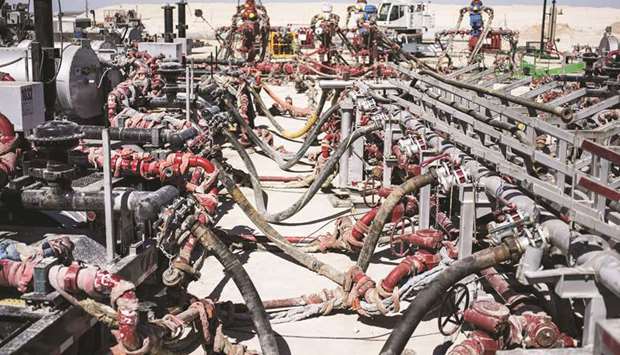There’s no denying that fracking has turned the US into a force in the global oil and gas markets, which has more than a few people abuzz about the prospect of energy independence.
But now, researchers at MIT have uncovered one potentially game-changing detail: a flaw in the Energy Department’s official forecast, which may vastly overstate oil and gas production in the years to come.
The culprit, they say, lies in the Energy Information Administration’s premise that better technology has been behind nearly all the recent output gains, and will continue to boost production for the foreseeable future. That’s not quite right. Instead, the research suggests increases have been largely due to something more mundane: low energy prices, which led drillers to focus on sweet spots where oil and gas are easiest to extract.
“The EIA is assuming that productivity of individual wells will continue to rise as a result of improvements in technology,” said Justin B Montgomery, a researcher at the Massachusetts Institute of Technology and one of the study’s authors. “This compounds year after year, like interest, so the further out in the future the wells are drilled, the more that they are being overestimated.”
Extrapolating from field studies Montgomery and his colleague Francis O’Sullivan conducted in North Dakota’s Bakken shale deposit, the research suggests that total US oil and natural-gas production from new wells could undershoot the EIA estimate by more than 10% in 2020. Things would get progressively worse each year after that as wells in various sweet spots are exhausted and technology fails to close the gap.
“The same forecasting methods are used in other plays in the US, and the same dynamic is likely to be present,” Montgomery added.
Margaret Coleman, the EIA’s leader of oil, gas and biofuels exploration and production analysis, said in an e-mail “the study raises valid points” and the administration is looking at ways to give its estimates a tighter focus. She added that many shale fields lack the detailed well data that informed the MIT study, which means EIA forecasters have to use known geologic information and assumptions about prices and technology to come up with estimates.
There’s little doubt the technologies used to extract oil and natural gas trapped within rock formations thousands of feet below the Earth’s surface — like drill heads, mapping software, fracking techniques and so on — have gotten better. And intuitively, it makes a lot of sense that better methods have boosted US shale output and helped lead to new finds.
“It’s really hard to bet against the ability of the industry to improve and get more out of the rock,” said Manuj Nikhanj, co-chief executive officer of RS Energy Group.
Just last month, International Energy Agency Executive Director Fatih Birol said shale production will make the US the “undisputed leader of global oil and gas markets for decades to come.”
But if the MIT researchers are ultimately right, the implications could be significant.
In the past three years, oil prices have been stuck around $50 a barrel on the back of rising shale output in the US, while natural gas has been selling for an average of less than $3 per million British thermal units. (As recently as 2014, prices for both were twice as high.)
Not only could a slowdown in production mean higher energy prices, but it also might just mark the end of the US shale industry’s role as the one swing producer able to counter Opec’s might. The shale boom has repeatedly frustrated the Saudi-led group’s attempts to control oil prices.
As recently as 2015, Opec tried to pump its US rivals out of business, but shale drillers adapted by reducing costs. On Thursday, the Organisation of Petroleum Exporting Countries and its allies agreed to maintain oil-output cuts through 2018, extending a campaign to wrest back the global market from America’s shale industry.
President Donald Trump himself has talked up “energy dominance” as a key policy, with US oil and gas helping supply the world’s power needs.
Of course, the MIT researchers aren’t the first to question the projected growth of US shale. Analysts have long debated varying methods used to predict output. And unsurprisingly, the Saudis have cast doubt on how long the shale boom can last. Even billionaire oilman Harold Hamm recently slammed what he considered EIA’s “exaggerated” forecasts, saying they’re depressing US oil prices. (After all, higher prices are better for the bottom line.)
Yet, MIT’s findings stand out by providing some evidence that backs those assertions. The problem with the EIA’s numbers, the researchers say, is that they give drillers too much credit for coming up with ways to improve fracking.
While the EIA’s model assumes that technical advances — such as well length and the amounts of water and sand used in fracking — increase output at new wells by roughly 10% each year, MIT findings from the Bakken region suggest it’s closer to 6.5%, according to Montgomery.
Increasing productivity of each new well matters because it’s the only way to boost output. Typically, production drops precipitously soon after a well is tapped. The EIA recently estimated about half of US oil output came from wells two or fewer years old.
So even though output in the Bakken more than tripled from 2012 to mid-2015 on a per-well basis, MIT’s research suggests the main reason is that shale companies abandoned iffier fields to drill in the best acreage following the slump in energy prices.
“There certainly could be some validity to getting a rosier forecast because right now, the industry is working sweet spots,” said Dave Yoxtheimer, a hydrogeologist at Penn State University’s Marcellus Center for Outreach and Research. “When that’s all played out, they’re going to have to go to the tier-two acreage, which isn’t going to be as productive.”
Indeed, some signs of a slowdown have started to emerge. Gas output in the Marcellus basin has fallen 10% on a per-rig basis since reaching a high in September 2016. In the Permian, per-rig oil production has decreased almost 20% over a similar span. Richard Bereschik knows firsthand that shale isn’t a sure thing.
The bearded, burly superintendent of schools in Wellsville, Ohio — a small, Rust Belt community located along the western bank of the Ohio River — recalls the rush he and other townsfolk experienced when Chesapeake Energy Corp came through some six years ago, leasing out huge tracts of property for development.
Wellsville sits atop the Marcellus and Utica shale formations and is only 20 miles from a concentration of sweet spots, but Bereschik says Chesapeake stopped renewing leases after the bottom fell out in prices.
“Everyone thought we’d found a goose that laid the golden egg,” Bereschik said. But ultimately, “it’s not the boom we all expected.”
Machinery used to fracture shale formations at a Royal Dutch Shell hydraulic fracking site near Mentone, Texas. Researchers at MIT have uncovered one potentially game-changing detail: a flaw in the Energy Department’s official forecast, which may vastly overstate oil and gas production in the years to come.



